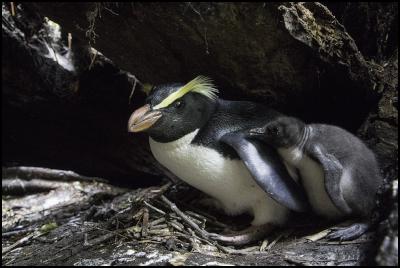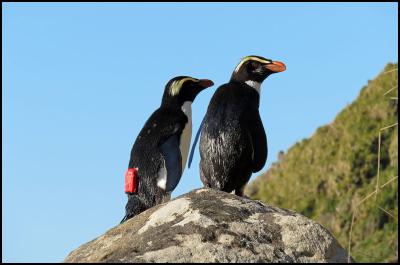Citizen science discovers tawaki tally in Milford Sound
Media release: 2 December 2016

Tawaki and chick in Milford
Sound. Credit Thomas Mattern
Citizen science discovers terrific tawaki tally in Milford Sound
A search for the elusive Fiordland crested penguin/ tawaki in Milford Sound/ Piopiotahi has revealed the birds to be thriving.
The Tawaki Project, a collaboration between the Department of Conservation, University of Otago, Global Penguin Society, and West Coast Penguin Trust, is the first major research on tawaki numbers since the 1970s. The project aims to identify sea-based factors that influence the penguins’ foraging and breeding success along the coastlines of South Westland, Fiordland, Stewart Island and Codfish Island.
Dr Thomas Mattern, who leads the project, said tawaki breed mainly in remote and inaccessible areas:
“This not only makes the birds difficult to observe, but also challenging to study. As a result, very little is known about the species.”
However, with tip-offs from local operators, their search revealed more than 60 breeding pairs in Milford Sound/Piopiotahi.
“There are still areas we haven’t searched,” said Thomas Mattern, “and from what we have seen this year, there might be more than 100 breeding pairs in Milford Sound.”
With logistical support from local tourism operator, Southern Discoveries, scientists tracked the Milford Sound/Piopiotahi tawaki using miniaturised GPS data loggers, as well as pressure and temperature sensors. This allowed the project team to reconstruct the penguins’ at-sea movements in 3D.
“We used tape in various colours to attach the devices, which made the birds easy to identify by boat skippers, nature guides and visitors. Southern Discoveries collated this information turning the Tawaki Project into a true citizen science venture.” Thomas Mattern said.

Tawaki with gps logger.
Credit Dave Houston
The 2016 survey also confirmed previous years’ findings that while tawaki on the West Coast travel up to 100km from their breeding colonies in search of food, those in Milford Sound/Piopiotahi seldom travelled further than half way up the fjord.
The news, however, wasn’t all good for the project team. At Jackson Head on the West Coast, they witnessed the devastating effects of stoats on the penguins:
“Within a matter of days almost all the eggs and chicks of the entire penguin colony – around 150 breeding pairs – were wiped out by stoats.” Thomas Mattern said.
“Stoat trapping in Milford Sound has enabled the population there to thrive. However, without any predator control in place, the reproductive outcome of tawaki at Jackson Head was close to zero for the second year in a row.”
Tawaki are the third rarest penguin species world-wide, behind the Galapagos penguin and the yellow-eyed penguin. The current population is thought to be between 2500 and 3000 breeding pairs and has been in decline since the 1950s.
–Ends–


 Gordon Campbell: On bird flu, AUKUS entry fees and Cindy Lee
Gordon Campbell: On bird flu, AUKUS entry fees and Cindy Lee Labour Party: Penny Drops – But What About Seymour And Peters?
Labour Party: Penny Drops – But What About Seymour And Peters? Government: PM Announces Changes To Portfolios
Government: PM Announces Changes To Portfolios Family First: Just 1 In 6 Oppose ‘Three Strikes’ - Poll
Family First: Just 1 In 6 Oppose ‘Three Strikes’ - Poll Labour Party: Budget Blunder Shows Nicola Willis Could Cut Recovery Funding
Labour Party: Budget Blunder Shows Nicola Willis Could Cut Recovery Funding  Government: Urgent Changes To System Through First RMA Amendment Bill
Government: Urgent Changes To System Through First RMA Amendment Bill Peace Movement Aotearoa: Global Military Spending Increase Threatens Humanity And The Planet
Peace Movement Aotearoa: Global Military Spending Increase Threatens Humanity And The Planet


